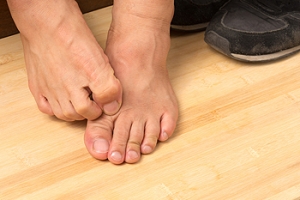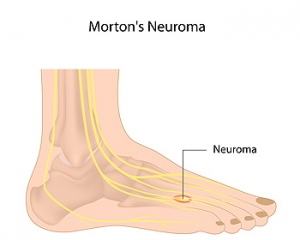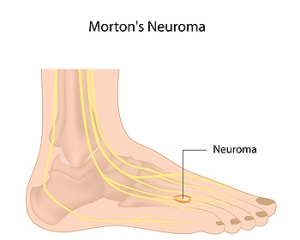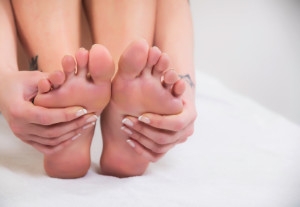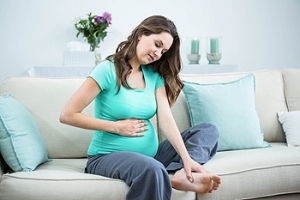Items filtered by date: August 2020
Children and Athlete’s Foot
A noticeable sign that your child may have athlete’s foot can be scratching on the bottom of the foot and between the toes. This type of fungus generally causes the skin to become red and scaly, and the affected foot may emit an odor. In severe cases, this condition can produce a rash, and your child may complain of a burning and tingling sensation. Athlete’s foot is contagious, and can develop as a result of frequenting public swimming pools, locker rooms, and surrounding areas. If your child has this condition, it is suggested that you consult with a podiatrist who can prescribe medication for relief.
Athlete’s foot is an inconvenient condition that can be easily reduced with the proper treatment. If you have any concerns about your feet and ankles, contact Dr. Kenneth Donovan from Advanced Care Foot and Ankle.
Our doctor will treat your foot and ankle needs.
Athlete’s Foot: The Sole Story
Athlete's foot, also known as tinea pedis, can be an extremely contagious foot infection. It is commonly contracted in public changing areas and bathrooms, dormitory style living quarters, around locker rooms and public swimming pools, or anywhere your feet often come into contact with other people.
Solutions to Combat Athlete’s Foot
- Hydrate your feet by using lotion
- Exfoliate
- Buff off nails
- Use of anti-fungal products
- Examine your feet and visit your doctor if any suspicious blisters or cuts develop
Athlete’s foot can cause many irritating symptoms such as dry and flaking skin, itching, and redness. Some more severe symptoms can include bleeding and cracked skin, intense itching and burning, and even pain when walking. In the worst cases, Athlete’s foot can cause blistering as well. Speak to your podiatrist for a better understanding of the different causes of Athlete’s foot, as well as help in determining which treatment options are best for you.
If you have any questions please feel free to contact one of our offices located in Warren, Livingston, and Toms River, NJ . We offer the newest diagnostic and treatment technologies for all your foot and ankle needs.
Children and Athlete’s Foot
 A noticeable sign that your child may have athlete’s foot can be scratching on the bottom of the foot and between the toes. This type of fungus generally causes the skin to become red and scaly, and the affected foot may emit an odor. In severe cases, this condition can produce a rash, and your child may complain of a burning and tingling sensation. Athlete’s foot is contagious, and can develop as a result of frequenting public swimming pools, locker rooms, and surrounding areas. If your child has this condition, it is suggested that you consult with a podiatrist who can prescribe medication for relief.
A noticeable sign that your child may have athlete’s foot can be scratching on the bottom of the foot and between the toes. This type of fungus generally causes the skin to become red and scaly, and the affected foot may emit an odor. In severe cases, this condition can produce a rash, and your child may complain of a burning and tingling sensation. Athlete’s foot is contagious, and can develop as a result of frequenting public swimming pools, locker rooms, and surrounding areas. If your child has this condition, it is suggested that you consult with a podiatrist who can prescribe medication for relief.
Athlete’s foot is an inconvenient condition that can be easily reduced with the proper treatment. If you have any concerns about your feet and ankles, contact Dr. Kenneth Donovan from Advanced Care Foot and Ankle. Our doctor will treat your foot and ankle needs.
Athlete’s Foot: The Sole Story
Athlete's foot, also known as tinea pedis, can be an extremely contagious foot infection. It is commonly contracted in public changing areas and bathrooms, dormitory style living quarters, around locker rooms and public swimming pools, or anywhere your feet often come into contact with other people.
Solutions to Combat Athlete’s Foot
- Hydrate your feet by using lotion
- Exfoliate
- Buff off nails
- Use of anti-fungal products
- Examine your feet and visit your doctor if any suspicious blisters or cuts develop
Athlete’s foot can cause many irritating symptoms such as dry and flaking skin, itching, and redness. Some more severe symptoms can include bleeding and cracked skin, intense itching and burning, and even pain when walking. In the worst cases, Athlete’s foot can cause blistering as well. Speak to your podiatrist for a better understanding of the different causes of Athlete’s foot, as well as help in determining which treatment options are best for you.
If you have any questions please feel free to contact one of our offices located in Warren, Livingston, and Toms River, NJ . We offer the newest diagnostic and treatment technologies for all your foot and ankle needs.
What is Morton’s Neuroma?
A neuroma is the thickening of a nerve, and Morton’s neuroma particularly involves the thickening of the nerve between the third and fourth toe. This nerve, which is normally 2mm wide, can grow up to 15mm in size and can be easily irritated by the bones surrounding it. Common symptoms of Morton’s neuroma include a sharp stabbing and or shooting pain, a burning or tingling sensation, or numbness in the toes.
Treatments of this ailment can include orthotics, adding padding to the foot or shoes worn to decrease pressure and irritation, or injections of local corticosteroids to reduce the inflammation. These conservative methods have a high success rate however, if the neuroma is not treated and continues to grow and cause more severe pain, surgery may be necessary. If you are experiencing pain in your toes or the ball of your foot, it is important to visit a podiatrist for a proper diagnosis and correct treatment.
Morton’s neuroma is a very uncomfortable condition to live with. If you think you have Morton’s neuroma, contact Dr. Kenneth Donovan of Advanced Care Foot and Ankle. Our doctor will attend to all of your foot care needs and answer any of your related questions.
Morton’s Neuroma
Morton's neuroma is a painful foot condition that commonly affects the areas between the second and third or third and fourth toe, although other areas of the foot are also susceptible. Morton’s neuroma is caused by an inflamed nerve in the foot that is being squeezed and aggravated by surrounding bones.
What Increases the Chances of Having Morton’s Neuroma?
- Ill-fitting high heels or shoes that add pressure to the toe or foot
- Jogging, running or any sport that involves constant impact to the foot
- Flat feet, bunions, and any other foot deformities
Morton’s neuroma is a very treatable condition. Orthotics and shoe inserts can often be used to alleviate the pain on the forefront of the feet. In more severe cases, corticosteroids can also be prescribed. In order to figure out the best treatment for your neuroma, it’s recommended to seek the care of a podiatrist who can diagnose your condition and provide different treatment options.
If you have any questions, please feel free to contact one of our offices located in Warren, Livingston, and Toms River, NJ . We offer the newest diagnostic and treatment technologies for all your foot care needs.
What is Morton’s Neuroma?
 A neuroma is the thickening of a nerve, and Morton’s neuroma particularly involves the thickening of the nerve between the third and fourth toe. This nerve, which is normally 2mm wide, can grow up to 15mm in size and can be easily irritated by the bones surrounding it. Common symptoms of Morton’s neuroma include a sharp stabbing and or shooting pain, a burning or tingling sensation, or numbness in the toes. Treatments of this ailment can include orthotics, adding padding to the foot or shoes worn to decrease pressure and irritation, or injections of local corticosteroids to reduce the inflammation. These conservative methods have a high success rate however, if the neuroma is not treated and continues to grow and cause more severe pain, surgery may be necessary. If you are experiencing pain in your toes or the ball of your foot, it is important to visit a podiatrist for a proper diagnosis and correct treatment.
A neuroma is the thickening of a nerve, and Morton’s neuroma particularly involves the thickening of the nerve between the third and fourth toe. This nerve, which is normally 2mm wide, can grow up to 15mm in size and can be easily irritated by the bones surrounding it. Common symptoms of Morton’s neuroma include a sharp stabbing and or shooting pain, a burning or tingling sensation, or numbness in the toes. Treatments of this ailment can include orthotics, adding padding to the foot or shoes worn to decrease pressure and irritation, or injections of local corticosteroids to reduce the inflammation. These conservative methods have a high success rate however, if the neuroma is not treated and continues to grow and cause more severe pain, surgery may be necessary. If you are experiencing pain in your toes or the ball of your foot, it is important to visit a podiatrist for a proper diagnosis and correct treatment.
Morton’s neuroma is a very uncomfortable condition to live with. If you think you have Morton’s neuroma, contact Dr. Kenneth Donovan of Advanced Care Foot and Ankle. Our doctor will attend to all of your foot care needs and answer any of your related questions.
Morton’s Neuroma
Morton's neuroma is a painful foot condition that commonly affects the areas between the second and third or third and fourth toe, although other areas of the foot are also susceptible. Morton’s neuroma is caused by an inflamed nerve in the foot that is being squeezed and aggravated by surrounding bones.
What Increases the Chances of Having Morton’s Neuroma?
- Ill-fitting high heels or shoes that add pressure to the toe or foot
- Jogging, running or any sport that involves constant impact to the foot
- Flat feet, bunions, and any other foot deformities
Morton’s neuroma is a very treatable condition. Orthotics and shoe inserts can often be used to alleviate the pain on the forefront of the feet. In more severe cases, corticosteroids can also be prescribed. In order to figure out the best treatment for your neuroma, it’s recommended to seek the care of a podiatrist who can diagnose your condition and provide different treatment options.
If you have any questions, please feel free to contact one of our offices located in Warren, Livingston, and Toms River, NJ . We offer the newest diagnostic and treatment technologies for all your foot care needs.
Strengthening Flat Feet
Flat feet often don’t cause any symptoms, however, they can make you more likely to develop foot problems over time. If you want to keep your feet healthy and in good condition, there are many stretching and strengthening exercises that you can try. Toe Scrunches work out the small muscles of the feet, making them stronger and more flexible at the arch. To do Toe Scrunches, place a towel on the floor and put your feet directly on top of it. Using only your toes, scrunch up the towel by moving your toes inward towards the balls of your feet. Another exercise you can do is called Can-Rolling. Sit on a chair and place a can lying down on the floor in front of you. Put your foot on top of the can so that the can is under your arch, then roll the can back and forth using your foot. This exercise stretches your feet while relieving tension and pressure. For more exercise ideas and information on strengthening flat feet, consult with a podiatrist.
Flatfoot is a condition many people suffer from. If you have flat feet, contact Dr. Kenneth Donovan from Advanced Care Foot and Ankle. Our doctor will treat your foot and ankle needs.
What Are Flat Feet?
Flatfoot is a condition in which the arch of the foot is depressed and the sole of the foot is almost completely in contact with the ground. About 20-30% of the population generally has flat feet because their arches never formed during growth.
Conditions & Problems:
Having flat feet makes it difficult to run or walk because of the stress placed on the ankles.
Alignment – The general alignment of your legs can be disrupted, because the ankles move inward which can cause major discomfort.
Knees – If you have complications with your knees, flat feet can be a contributor to arthritis in that area.
Symptoms
- Pain around the heel or arch area
- Trouble standing on the tip toe
- Swelling around the inside of the ankle
- Flat look to one or both feet
- Having your shoes feel uneven when worn
Treatment
If you are experiencing pain and stress on the foot you may weaken the posterior tibial tendon, which runs around the inside of the ankle.
If you have any questions please feel free to contact one of our offices located in Warren, Livingston, and Toms River, NJ . We offer the newest diagnostic and treatment technologies for all your foot and ankle needs.
Strengthening Flat Feet
 Flat feet often don’t cause any symptoms, however, they can make you more likely to develop foot problems over time. If you want to keep your feet healthy and in good condition, there are many stretching and strengthening exercises that you can try. Toe Scrunches work out the small muscles of the feet, making them stronger and more flexible at the arch. To do Toe Scrunches, place a towel on the floor and put your feet directly on top of it. Using only your toes, scrunch up the towel by moving your toes inward towards the balls of your feet. Another exercise you can do is called Can-Rolling. Sit on a chair and place a can lying down on the floor in front of you. Put your foot on top of the can so that the can is under your arch, then roll the can back and forth using your foot. This exercise stretches your feet while relieving tension and pressure. For more exercise ideas and information on strengthening flat feet, consult with a podiatrist.
Flat feet often don’t cause any symptoms, however, they can make you more likely to develop foot problems over time. If you want to keep your feet healthy and in good condition, there are many stretching and strengthening exercises that you can try. Toe Scrunches work out the small muscles of the feet, making them stronger and more flexible at the arch. To do Toe Scrunches, place a towel on the floor and put your feet directly on top of it. Using only your toes, scrunch up the towel by moving your toes inward towards the balls of your feet. Another exercise you can do is called Can-Rolling. Sit on a chair and place a can lying down on the floor in front of you. Put your foot on top of the can so that the can is under your arch, then roll the can back and forth using your foot. This exercise stretches your feet while relieving tension and pressure. For more exercise ideas and information on strengthening flat feet, consult with a podiatrist.
Flatfoot is a condition many people suffer from. If you have flat feet, contact Dr. Kenneth Donovan from Advanced Care Foot and Ankle. Our doctor will treat your foot and ankle needs.
What Are Flat Feet?
Flatfoot is a condition in which the arch of the foot is depressed and the sole of the foot is almost completely in contact with the ground. About 20-30% of the population generally has flat feet because their arches never formed during growth.
Conditions & Problems:
Having flat feet makes it difficult to run or walk because of the stress placed on the ankles.
Alignment – The general alignment of your legs can be disrupted, because the ankles move inward which can cause major discomfort.
Knees – If you have complications with your knees, flat feet can be a contributor to arthritis in that area.
Symptoms
- Pain around the heel or arch area
- Trouble standing on the tip toe
- Swelling around the inside of the ankle
- Flat look to one or both feet
- Having your shoes feel uneven when worn
Treatment
If you are experiencing pain and stress on the foot you may weaken the posterior tibial tendon, which runs around the inside of the ankle.
If you have any questions please feel free to contact one of our offices located in Warren, Livingston, and Toms River, NJ . We offer the newest diagnostic and treatment technologies for all your foot and ankle needs.
Wounds That Don’t Heal Need to Be Checked
Your feet are covered most of the day. If you're diabetic, periodic screening is important for good health. Numbness is often a sign of diabetic foot and can mask a sore or wound.
Pregnancy and Its Effects on the Feet
Pregnancy may alter a woman’s body tremendously, affecting different body parts, including the feet in particular. Due to the added weight put on throughout pregnancy, the pressure that is being put on the feet may begin to increase. When this happens, the feet can slowly begin to flatten. Another change women can experience throughout pregnancy is the swelling of their feet. Again, the added weight and pressure of the growing fetus can take a toll on the feet, which can cause them to swell. When this occurs, elevating the feet as often as possible can help lessen the swelling. For more advice on how to treat the changes of your feet during pregnancy, please consult with a podiatrist.
Pregnant women with swollen feet can be treated with a variety of different methods that are readily available. For more information about other cures for swollen feet during pregnancy, consult with Dr. Kenneth Donovan from Advanced Care Foot and Ankle. Our doctor will attend to all of your foot and ankle needs.
What Foot Problems Can Arise During Pregnancy?
One problem that can occur is overpronation, which occurs when the arch of the foot flattens and tends to roll inward.
This can cause pain and discomfort in your heels while you’re walking or even just standing up, trying to support your baby.
Another problem is edema, or swelling in the extremities. This often affects the feet during pregnancy but tends to occur in the later stages.
How Can I Keep My Feet Healthy During Pregnancy?
- Wearing orthotics can provide extra support for the feet and help distribute weight evenly
- Minimize the amount of time spent walking barefoot
- Wear shoes with good arch support
- Wear shoes that allow for good circulation to the feet
- Elevate feet if you experience swelling
- Massage your feet
- Get regular, light exercise, such as walking, to promote blood circulation to the feet
If you have any questions please feel free to contact one of our offices located in Warren, Livingston, and Toms River, NJ . We offer the newest diagnostic and treatment technologies for all your foot and ankle needs.
Pregnancy and Its Effects on the Feet
 Pregnancy may alter a woman’s body tremendously, affecting different body parts, including the feet in particular. Due to the added weight put on throughout pregnancy, the pressure that is being put on the feet may begin to increase. When this happens, the feet can slowly begin to flatten. Another change women can experience throughout pregnancy is the swelling of their feet. Again, the added weight and pressure of the growing fetus can take a toll on the feet, which can cause them to swell. When this occurs, elevating the feet as often as possible can help lessen the swelling. For more advice on how to treat the changes of your feet during pregnancy, please consult with a podiatrist.
Pregnancy may alter a woman’s body tremendously, affecting different body parts, including the feet in particular. Due to the added weight put on throughout pregnancy, the pressure that is being put on the feet may begin to increase. When this happens, the feet can slowly begin to flatten. Another change women can experience throughout pregnancy is the swelling of their feet. Again, the added weight and pressure of the growing fetus can take a toll on the feet, which can cause them to swell. When this occurs, elevating the feet as often as possible can help lessen the swelling. For more advice on how to treat the changes of your feet during pregnancy, please consult with a podiatrist.
Pregnant women with swollen feet can be treated with a variety of different methods that are readily available. For more information about other cures for swollen feet during pregnancy, consult with Dr. Kenneth Donovan from Advanced Care Foot and Ankle. Our doctor will attend to all of your foot and ankle needs.
What Foot Problems Can Arise During Pregnancy?
One problem that can occur is overpronation, which occurs when the arch of the foot flattens and tends to roll inward. This can cause pain and discomfort in your heels while you’re walking or even just standing up, trying to support your baby.
Another problem is edema, or swelling in the extremities. This often affects the feet during pregnancy but tends to occur in the later stages.
How Can I Keep My Feet Healthy During Pregnancy?
- Wearing orthotics can provide extra support for the feet and help distribute weight evenly
- Minimize the amount of time spent walking barefoot
- Wear shoes with good arch support
- Wear shoes that allow for good circulation to the feet
- Elevate feet if you experience swelling
- Massage your feet
- Get regular, light exercise, such as walking, to promote blood circulation to the feet
If you have any questions please feel free to contact one of our offices located in Warren, Livingston, and Toms River, NJ . We offer the newest diagnostic and treatment technologies for all your foot and ankle needs.
